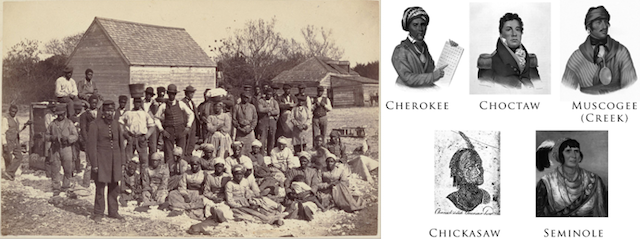
Did you know that the 13th Amendment abolishing slavery did not apply to ALL slaves?
Most see slavery as a simple black-vs.-white issue. But those who do may not realize that the “Five Civilized Tribes” of the southeast — Cherokee, Chickasaw, Choctaw, Creek, and Seminole — also participated in the institution of slavery.
Because these tribes were located outside the sovereignty of the United States, constitutional amendments did not apply to them.
In the period before the arrival of the Europeans, the Natives practiced flexible forms of slavery that often allowed slaves avenues to freedom through intermarriage. That all changed with the arrival of the Europeans, who introduced Native Americans to a system of permanent bondage based on race.
According to journalist Aliana E. Roberts, this switch occurred after the Yamasee tribe lost a war against the English Carolina colonists in 1717. The Europeans began turning from Native slavery to African slavery, and the Native Americans followed their lead. Many Natives, especially those in the “Five Civilized Tribes” (so-called because they embraced the ways of American settlers) picked up on the trend. By 1800, they had developed “plantations that rivaled those of their white neighbors.”
Roberts states that like most average Americans, many Natives did not own black slaves. Most slaveowners were part of the upper-classes, and were those who had the most influence in society.
In spite of this she also notes that the percentage of black slaves in the population was not insignificant:
In 1860…Cherokee Nation citizens owned 2,511 slaves (15 percent of their total population), Choctaw citizens owned 2,349 slaves (14 percent of their total population), and Creek citizens owned 1,532 slaves (10 percent of their total population). Chickasaw citizens owned 975 slaves, which amounted to 18 percent of their total population, a proportion equivalent to that of white slave owners in Tennessee, a former neighbour of the Chickasaw Nation and a large slaveholding state.
While many Native American nations allowed white slaves to earn their freedom through intermarriage, the tribes also had strict laws forbidding any intermarriage between a Native and a black slave, often punishing those who married their slaves with banishment from the tribe.
The Native slaveowners could also be horrifyingly brutal towards their black slaves. This is illustrated by the case of Lucy, a black slave burned alive for the murder of her native master. She had no part in the murder but was executed anyway at the request of the murdered warrior’s wife.
During the Civil War, the “Five Civilized Tribes” fought on both the Union and Confederate sides. After the war, the Treaties of 1866 freed the slaves. Even after that, blacks still faced discrimination in the Indian territories, with many tribes passing laws similar to the infamous “Black Codes” in the South.
RELATED: 10 Black Slaveowners That Will Tear Apart Historical Perception
This often-overlooked part of American history takes on new significance in light of today’s debates over slavery reparations and monuments to those who owned slaves or fought to keep them.
Do the descendants of the “Five Civilized Tribes” owe reparations for slavery? Should monuments to their leaders be taken down? The institution of slavery was rightfully eradicated with the passage of the 13th Amendment. But any debate over how to deal with the legacy of this evil institution must remember that the phenomenon was much more complex than is often portrayed or remembered.
Written by Peter Partoll for Intellectual Takeout ~ July 5, 2019
